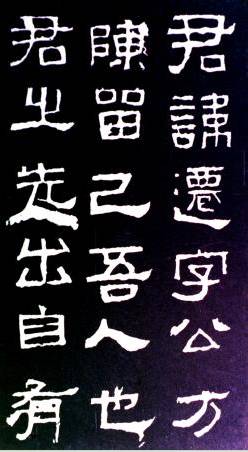Difference between revisions of "Lishu"
imported>Ciic m |
imported>Ciic |
||
| Line 1: | Line 1: | ||
| + | [[File:Inscription on Zhang Qian's Stele in lishu style.jpg|thumb|Inscription on Zhang Qian's Stele in lishu style]] | ||
'''''Lishu''''' germinated in pre-Qin times. By the [[Qin Dynasty]] (221-206 BC), it came to be used by low-ranking officials. It simplified the more complicated strokes of seal character script and used a bend instead of making a roundabout turn. | '''''Lishu''''' germinated in pre-Qin times. By the [[Qin Dynasty]] (221-206 BC), it came to be used by low-ranking officials. It simplified the more complicated strokes of seal character script and used a bend instead of making a roundabout turn. | ||
| Line 5: | Line 6: | ||
By the ''Han Dynasty'', it was promoted as a writing style. In over 400 years of propagation, ''lishu'' created many schools of writing. To facilitate writing, ''lishu'' branched out into ''xingshu'' (running script) and ''caoshu'' (cursive script), written in a flowing style with the strokes joined together. ''Lishu'' may be said to be the harbinger of running and cursive scripts. | By the ''Han Dynasty'', it was promoted as a writing style. In over 400 years of propagation, ''lishu'' created many schools of writing. To facilitate writing, ''lishu'' branched out into ''xingshu'' (running script) and ''caoshu'' (cursive script), written in a flowing style with the strokes joined together. ''Lishu'' may be said to be the harbinger of running and cursive scripts. | ||
| − | + | ||
[[category:culture]] | [[category:culture]] | ||
Latest revision as of 02:50, 4 April 2018
Lishu germinated in pre-Qin times. By the Qin Dynasty (221-206 BC), it came to be used by low-ranking officials. It simplified the more complicated strokes of seal character script and used a bend instead of making a roundabout turn.
Lishu is attributed to Cheng Miao, who lived in the State of Qin. The script was used by li (clerks working in prisons) hence the Chinese term lishu (servitude script).
By the Han Dynasty, it was promoted as a writing style. In over 400 years of propagation, lishu created many schools of writing. To facilitate writing, lishu branched out into xingshu (running script) and caoshu (cursive script), written in a flowing style with the strokes joined together. Lishu may be said to be the harbinger of running and cursive scripts.
